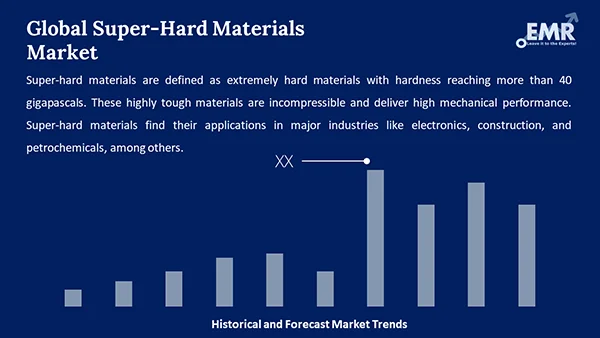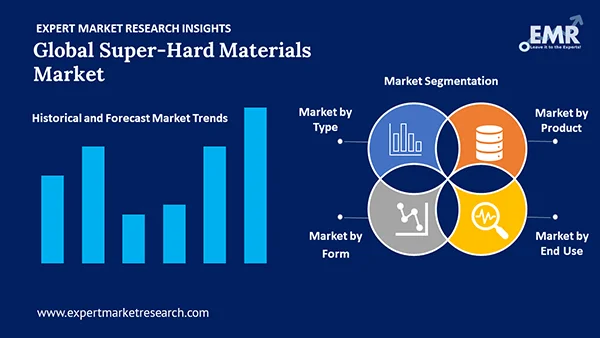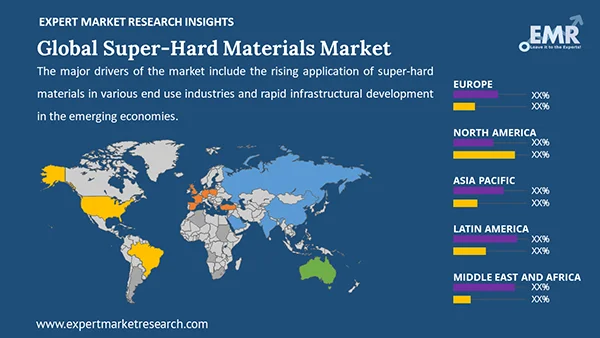Reports
Sale

Global Super-Hard Materials Market Size, Share, Forecast: By Type: Intrinsic, Extrinsic; By Product: Micron Diamond, Polycrystalline Diamond (PCD), Cubic Boron Nitride (CBN), Polycrystalline Cubic Boron Nitride (PCBN); By Form: Monocrystalline, Polycrystalline, Others; By End Use; Regional Analysis; Competitive Landscape; 2024-2032
Global Super-Hard Materials Market Outlook
The global super-hard materials market stood at a value of around USD 6.28 billion in 2023. The market is further expected to grow in the forecast period of 2024-2032 at a CAGR of 5.7% to reach about USD 10.33 billion by 2032.

Read more about this report - REQUEST FREE SAMPLE COPY IN PDF
Micron Diamond Segment Holds a Significant Share in the Global Super-Hard Materials Industry
As micron diamond is tough and has a high wear resistance, it is ideal for various industrial applications, such as cutting, drilling, polishing, grinding, etc., which is driving the market growth. It can effortlessly grind and polish hard alloys, ceramics, gems, and optical glass, among others, due to which its demand is significantly increasing. In addition, the growing use of micron diamond powder by major ceramic manufacturers is likely to aid the segment growth. The rising demand for precious stones in the jewellery industry is expected to further boost the demand for micron diamond, which is anticipated to propel the market for super-hard materials in the forecast period.
The Asia Pacific Accounts for a Significant Share in the Market for Super-Hard Materials
The super-hard materials industry in the Asia Pacific is driven by the rapid expansion of various end-use sectors in the region, including oil and gas, chemical and petroleum, automotive and transportation, and building and construction, among others. The market growth can also be attributed to the rising population, the increasing disposable incomes, the introduction of favourable government policies for the manufacturers, rapid urbanisation, and infrastructure development. Moreover, the increasing foreign direct investment in countries like India is likely to accelerate various development projects, thereby propelling the demand for super-hard materials.
Super-Hard Materials Market Segmentation
super-hard materials are defined as extremely hard materials with hardness reaching more than 40 gigapascals. These highly tough materials are incompressible and deliver high mechanical performance. super-hard materials find their applications in major industries like electronics, construction, and petrochemicals, among others.

Read more about this report - REQUEST FREE SAMPLE COPY IN PDF
Based on type, the market can be bifurcated into:
- Intrinsic
- Extrinsic
The different products of super-hard materials are as follows:
- Micron Diamond
- Polycrystalline Diamond (PCD)
- Cubic Boron Nitride (CBN)
- Polycrystalline Cubic Boron Nitride (PCBN)
The market, based on form, is segmented into:
- Monocrystalline
- Polycrystalline
- Composite
- Others
The major end uses of super-hard materials include:
- Automotive and Transportation
- Building and Constructions
- Chemicals and Petrochemicals
- Drilling, Mining and Quarry
- Electrical and Electronics
- Others
The EMR report looks into the regional markets for super-hard materials like North America, Europe, the Asia Pacific, Latin America, and the Middle East and Africa.

Read more about this report - REQUEST FREE SAMPLE COPY IN PDF
Rising Applications of Super-Hard Materials in the Building and Construction Sector to Boost the Market Growth
The rising application of super-hard materials in the building and construction industry is driving the market. This can be attributed to the high strength and wear-resistance of the materials that stabilise the structure, keeping it safe from earthquakes, tsunamis, and other natural calamities. Over the forecast period, the utilisation of super-hard materials in residential and commercial constructions is likely to boost the market growth in the forecast period. Although the high cost of some super-hard materials such as diamond is likely to impede the market, the rising demand for super-hard materials in drilling, quarrying, and mining is anticipated to provide impetus to the growth of the market. Further, the increasing interest in renewable resources is predicted to further fuel the industry growth in the coming years.
Key Industry Players in the Global Super-Hard Materials Market
The report gives a detailed analysis of the following key players in the global super-hard materials market, covering their competitive landscape, capacity, and latest developments like mergers, acquisitions, and investments, expansions of capacity, and plant turnarounds:
- ILJIN Diamond Co., Ltd.
- SF Diamond Co. Ltd.
- Henan Yalong Superhard Materials Co., Ltd.
- Element Six (UK) Ltd.
- Others
The comprehensive EMR report provides an in-depth assessment of the market based on the Porter's five forces model along with giving a SWOT analysis.
Key Highlights of the Report
| REPORT FEATURES | DETAILS |
| Base Year | 2023 |
| Historical Period | 2018-2023 |
| Forecast Period | 2024-2032 |
| Scope of the Report |
Historical and Forecast Trends, Industry Drivers and Constraints, Historical and Forecast Market Analysis by Segment:
|
| Breakup by Type |
|
| Breakup by Product |
|
| Breakup by Form |
|
| Breakup by End Use |
|
| Breakup by Region |
|
| Market Dynamics |
|
| Competitive Landscape |
|
| Companies Covered |
|
| Report Price and Purchase Option | Explore our purchase options that are best suited to your resources and industry needs. |
| Delivery Format | Delivered as an attached PDF and Excel through email, with an option of receiving an editable PPT, according to the purchase option. |
*While we strive to always give you current and accurate information, the numbers depicted on the website are indicative and may differ from the actual numbers in the main report. At Expert Market Research, we aim to bring you the latest insights and trends in the market. Using our analyses and forecasts, stakeholders can understand the market dynamics, navigate challenges, and capitalize on opportunities to make data-driven strategic decisions.
1 Preface
2 Report Coverage – Key Segmentation and Scope
3 Report Description
3.1 Market Definition and Outlook
3.2 Properties and Applications
3.3 Market Analysis
3.4 Key Players
4 Key Assumptions
5 Executive Summary
5.1 Overview
5.2 Key Drivers
5.3 Key Developments
5.4 Competitive Structure
5.5 Key Industrial Trends
6 Snapshot
6.1 Global
6.2 Regional
7 Opportunities and Challenges in the Market
8 Global Super-Hard Materials Market Analysis
8.1 Key Industry Highlights
8.2 Global Super-Hard Materials Historical Market (2018-2023)
8.3 Global Super-Hard Materials Market Forecast (2024-2032)
8.4 Global Super-Hard Materials Market by Type
8.4.1 Intrinsic
8.4.1.1 Market Share
8.4.1.2 Historical Trend (2018-2023)
8.4.1.3 Forecast Trend (2024-2032)
8.4.2 Extrinsic
8.4.2.1 Market Share
8.4.2.2 Historical Trend (2018-2023)
8.4.2.3 Forecast Trend (2024-2032)
8.5 Global Super-Hard Materials Market by Product
8.5.1 Micron Diamond
8.5.1.1 Market Share
8.5.1.2 Historical Trend (2018-2023)
8.5.1.3 Forecast Trend (2024-2032)
8.5.2 Polycrystalline Diamond (PCD)
8.5.2.1 Market Share
8.5.2.2 Historical Trend (2018-2023)
8.5.2.3 Forecast Trend (2024-2032)
8.5.3 Cubic Boron Nitride (CBN)
8.5.3.1 Market Share
8.5.3.2 Historical Trend (2018-2023)
8.5.3.3 Forecast Trend (2024-2032)
8.5.4 Polycrystalline Cubic Boron Nitride (PCBN)
8.5.4.1 Market Share
8.5.4.2 Historical Trend (2018-2023)
8.5.4.3 Forecast Trend (2024-2032)
8.6 Global Super-Hard Materials Market by Form
8.6.1 Monocrystalline
8.6.1.1 Market Share
8.6.1.2 Historical Trend (2018-2023)
8.6.1.3 Forecast Trend (2024-2032)
8.6.2 Polycrystalline
8.6.2.1 Market Share
8.6.2.2 Historical Trend (2018-2023)
8.6.2.3 Forecast Trend (2024-2032)
8.6.3 Composite
8.6.3.1 Market Share
8.6.3.2 Historical Trend (2018-2023)
8.6.3.3 Forecast Trend (2024-2032)
8.6.4 Others
8.7 Global Super-Hard Materials Market by End Use
8.7.1 Automotive and Transportation
8.7.1.1 Market Share
8.7.1.2 Historical Trend (2018-2023)
8.7.1.3 Forecast Trend (2024-2032)
8.7.2 Building and Constructions
8.7.2.1 Market Share
8.7.2.2 Historical Trend (2018-2023)
8.7.2.3 Forecast Trend (2024-2032)
8.7.3 Chemicals and Petrochemicals
8.7.3.1 Market Share
8.7.3.2 Historical Trend (2018-2023)
8.7.3.3 Forecast Trend (2024-2032)
8.7.4 Drilling, Mining and Quarry
8.7.4.1 Market Share
8.7.4.2 Historical Trend (2018-2023)
8.7.4.3 Forecast Trend (2024-2032)
8.7.5 Electrical and Electronics
8.7.5.1 Market Share
8.7.5.2 Historical Trend (2018-2023)
8.7.5.3 Forecast Trend (2024-2032)
8.7.6 Others
8.8 Global Super-Hard Materials Market by Region
8.8.1 North America
8.8.1.1 Market Share
8.8.1.2 Historical Trend (2018-2023)
8.8.1.3 Forecast Trend (2024-2032)
8.8.2 Europe
8.8.2.1 Market Share
8.8.2.2 Historical Trend (2018-2023)
8.8.2.3 Forecast Trend (2024-2032)
8.8.3 Asia Pacific
8.8.3.1 Market Share
8.8.3.2 Historical Trend (2018-2023)
8.8.3.3 Forecast Trend (2024-2032)
8.8.4 Latin America
8.8.4.1 Market Share
8.8.4.2 Historical Trend (2018-2023)
8.8.4.3 Forecast Trend (2024-2032)
8.8.5 Middle East and Africa
8.8.5.1 Market Share
8.8.5.2 Historical Trend (2018-2023)
8.8.5.3 Forecast Trend (2024-2032)
9 North America Super-Hard Materials Market Analysis
9.1 United States of America
9.1.1 Market Share
9.1.2 Historical Trend (2018-2023)
9.1.3 Forecast Trend (2024-2032)
9.2 Canada
9.2.1 Market Share
9.2.2 Historical Trend (2018-2023)
9.2.3 Forecast Trend (2024-2032)
10 Europe Super-Hard Materials Market Analysis
10.1 United Kingdom
10.1.1 Market Share
10.1.2 Historical Trend (2018-2023)
10.1.3 Forecast Trend (2024-2032)
10.2 Germany
10.2.1 Market Share
10.2.2 Historical Trend (2018-2023)
10.2.3 Forecast Trend (2024-2032)
10.3 France
10.3.1 Market Share
10.3.2 Historical Trend (2018-2023)
10.3.3 Forecast Trend (2024-2032)
10.4 Italy
10.4.1 Market Share
10.4.2 Historical Trend (2018-2023)
10.4.3 Forecast Trend (2024-2032)
10.5 Others
11 Asia Pacific Super-Hard Materials Market Analysis
11.1 China
11.1.1 Market Share
11.1.2 Historical Trend (2018-2023)
11.1.3 Forecast Trend (2024-2032)
11.2 Japan
11.2.1 Market Share
11.2.2 Historical Trend (2018-2023)
11.2.3 Forecast Trend (2024-2032)
11.3 India
11.3.1 Market Share
11.3.2 Historical Trend (2018-2023)
11.3.3 Forecast Trend (2024-2032)
11.4 ASEAN
11.4.1 Market Share
11.4.2 Historical Trend (2018-2023)
11.4.3 Forecast Trend (2024-2032)
11.5 Australia
11.5.1 Market Share
11.5.2 Historical Trend (2018-2023)
11.5.3 Forecast Trend (2024-2032)
11.6 Others
12 Latin America Super-Hard Materials Market Analysis
12.1 Brazil
12.1.1 Market Share
12.1.2 Historical Trend (2018-2023)
12.1.3 Forecast Trend (2024-2032)
12.2 Argentina
12.2.1 Market Share
12.2.2 Historical Trend (2018-2023)
12.2.3 Forecast Trend (2024-2032)
12.3 Mexico
12.3.1 Market Share
12.3.2 Historical Trend (2018-2023)
12.3.3 Forecast Trend (2024-2032)
12.4 Others
13 Middle East and Africa Super-Hard Materials Market Analysis
13.1 Saudi Arabia
13.1.1 Market Share
13.1.2 Historical Trend (2018-2023)
13.1.3 Forecast Trend (2024-2032)
13.2 United Arab Emirates
13.2.1 Market Share
13.2.2 Historical Trend (2018-2023)
13.2.3 Forecast Trend (2024-2032)
13.3 Nigeria
13.3.1 Market Share
13.3.2 Historical Trend (2018-2023)
13.3.3 Forecast Trend (2024-2032)
13.4 South Africa
13.4.1 Market Share
13.4.2 Historical Trend (2018-2023)
13.4.3 Forecast Trend (2024-2032)
13.5 Others
14 Market Dynamics
14.1 SWOT Analysis
14.1.1 Strengths
14.1.2 Weaknesses
14.1.3 Opportunities
14.1.4 Threats
14.2 Porter’s Five Forces Analysis
14.2.1 Supplier’s Power
14.2.2 Buyer’s Power
14.2.3 Threat of New Entrants
14.2.4 Degree of Rivalry
14.2.5 Threat of Substitutes
14.3 Key Indicators for Demand
14.4 Key Indicators for Price
15 Value Chain Analysis
16 Competitive Landscape
16.1 Market Structure
16.2 Company Profiles
16.2.1 ILJIN Diamond Co., Ltd.
16.2.1.1 Company Overview
16.2.1.2 Product Portfolio
16.2.1.3 Demographic Reach and Achievements
16.2.1.4 Certifications
16.2.2 SF Diamond Co. Ltd.
16.2.2.1 Company Overview
16.2.2.2 Product Portfolio
16.2.2.3 Demographic Reach and Achievements
16.2.2.4 Certifications
16.2.3 Henan Yalong Super-Hard Materials Co., Ltd.
16.2.3.1 Company Overview
16.2.3.2 Product Portfolio
16.2.3.3 Demographic Reach and Achievements
16.2.3.4 Certifications
16.2.4 Element Six (UK) Ltd.
16.2.4.1 Company Overview
16.2.4.2 Product Portfolio
16.2.4.3 Demographic Reach and Achievements
16.2.4.4 Certifications
16.2.5 Others
17 Key Trends and Developments in the Market
Additional Customisations Available
1 Manufacturing Process
1.1 Overview
1.2 Detailed Process Flow
1.3 Operation Involved
2 Project Requirement and Cost Analysis
2.1 Land, Location and Site Development
2.2 Construction
2.3 Plant Machinery
2.4 Cost of Raw Material
2.5 Packaging
2.6 Transportation
2.7 Utilities
2.8 Manpower
2.9 Other Capital Investment
List of Key Figures and Tables
1. Global Super-Hard Materials Market: Key Industry Highlights, 2018 and 2032
2. Global Super-Hard Materials Historical Market: Breakup by Product Type (USD Billion), 2018-2023
3. Global Super-Hard Materials Market Forecast: Breakup by Product Type (USD Billion), 2024-2032
4. Global Super-Hard Materials Historical Market: Breakup by Form (USD Billion), 2018-2023
5. Global Super-Hard Materials Market Forecast: Breakup by Form (USD Billion), 2024-2032
6. Global Super-Hard Materials Historical Market: Breakup by End Use (USD Billion), 2018-2023
7. Global Super-Hard Materials Market Forecast: Breakup by End Use (USD Billion), 2024-2032
8. Global Super-Hard Materials Historical Market: Breakup by Region (USD Billion), 2018-2023
9. Global Super-Hard Materials Market Forecast: Breakup by Region (USD Billion), 2024-2032
10. North America Super-Hard Materials Historical Market: Breakup by Country (USD Billion), 2018-2023
11. North America Super-Hard Materials Market Forecast: Breakup by Country (USD Billion), 2024-2032
12. Europe Super-Hard Materials Historical Market: Breakup by Country (USD Billion), 2018-2023
13. Europe Super-Hard Materials Market Forecast: Breakup by Country (USD Billion), 2024-2032
14. Asia Pacific Super-Hard Materials Historical Market: Breakup by Country (USD Billion), 2018-2023
15. Asia Pacific Super-Hard Materials Market Forecast: Breakup by Country (USD Billion), 2024-2032
16. Latin America Super-Hard Materials Historical Market: Breakup by Country (USD Billion), 2018-2023
17. Latin America Super-Hard Materials Market Forecast: Breakup by Country (USD Billion), 2024-2032
18. Middle East and Africa Super-Hard Materials Historical Market: Breakup by Country (USD Billion), 2018-2023
19. Middle East and Africa Super-Hard Materials Market Forecast: Breakup by Country (USD Billion), 2024-2032
20. Global Super-Hard Materials Market Structure
In 2023, the global super-hard materials market attained a value of nearly USD 6.28 billion.
The market is estimated to grow at a CAGR of 5.7% between 2024 and 2032.
The market is estimated to witness a healthy growth in the forecast period of 2024-2032 to reach around USD 10.33 billion by 2032.
The major regions in the industry are North America, Latin America, the Middle East and Africa, Europe, and the Asia Pacific.
The major drivers of the market include the rising application of super-hard materials in various end use industries and rapid infrastructural development in the emerging economies.
The growing R&D activities and technological advancements in the electrical and electronics industry are expected to drive the growth of the industry.
Intrinsic and extrinsic are the major types included in the market.
Micron diamond, polycrystalline diamond (PCD), cubic boron nitride (CBN), and polycrystalline cubic boron nitride (PCBN) are the different products of super-hard materials.
The various forms of super-hard materials are monocrystalline, polycrystalline, and composite, among others.
Automotive and transportation, building and constructions, chemicals and petrochemicals, drilling, mining, and quarry, and electrical and electronics, among others, are the significant end uses of super-hard materials.
The major players in the industry are ILJIN Diamond Co., Ltd., SF Diamond Co. Ltd., Henan Yalong Superhard Materials Co., Ltd., and Element Six (UK) Ltd., among others.
The global super-hard materials market attained a value of nearly USD 6.28 billion in 2023, driven by the thriving automotive and transportation industry. Aided by technological advancements in the electrical and electronics industry, the market is expected to witness a further growth in the forecast period of 2024-2032, growing at a CAGR of 5.7%. The market is projected to reach about USD 10.33 billion by 2032.
EMR’s meticulous research methodology delves deep into the market, covering the macro and micro aspects of the industry. Based on type, the super-hard materials industry is divided into intrinsic and extrinsic. On the basis of product, the market is segmented into micron diamond, polycrystalline diamond (PCD), cubic boron nitride (CBN), and polycrystalline cubic boron nitride (PCBN). By form, the market is classified into monocrystalline, polycrystalline, and composite, among others. Based on end uses, the market is segmented into automotive and transportation, building and constructions, chemicals and petrochemicals, drilling, mining, and quarry, and electrical and electronics, among others. The major regional markets for super-hard materials are North America, Europe, the Asia Pacific, Latin America, and the Middle East and Africa. The key players in the above market include ILJIN Diamond Co., Ltd., SF Diamond Co. Ltd., Henan Yalong Superhard Materials Co., Ltd., and Element Six (UK) Ltd., among others.
EMR’s research methodology uses a combination of cutting-edge analytical tools and the expertise of their highly accomplished team, thus, providing their customers with market insights that are accurate, actionable, and help them remain ahead of their competition.
Datasheet
-
Selected Sections, One User
-
Printing Not Allowed
-
Email Delivery in PDF
-
Free Limited Customisation -
Post Sales Analyst Support -
50% Discount on Next Update
Single User License
-
All Sections, One User
-
One Print Allowed
-
Email Delivery in PDF
-
Free Limited Customisation -
Post Sales Analyst Support -
50% Discount on Next Update

Five User License
-
All Sections, Five Users
-
Five Prints Allowed
-
Email Delivery in PDF
-
Free Limited Customisation
-
Post Sales Analyst Support
-
50% Discount on Next Update
Corporate License
-
All Sections, Unlimited Users
-
Unlimited Prints Allowed
-
Email Delivery in PDF + Excel
-
Free Limited Customisation
-
Post Sales Analyst Support
-
50% Discount on Next Update
Any Question? Speak With An Analyst
View A Sample
Did You Miss Anything, Ask Now
Right People
We are technically excellent, strategic, practical, experienced and efficient; our analysts are hand-picked based on having the right attributes to work successfully and execute projects based on your expectations.
Right Methodology
We leverage our cutting-edge technology, our access to trusted databases, and our knowledge of the current models used in the market to deliver you research solutions that are tailored to your needs and put you ahead of the curve.
Right Price
We deliver in-depth and superior quality research in prices that are reasonable, unmatchable, and shows our understanding of your resource structure. We, additionally, offer attractive discounts on our upcoming reports.
Right Support
Our team of expert analysts are at your beck and call to deliver you optimum results that are customised to meet your precise needs within the specified timeframe and help you form a better understanding of the industry.


